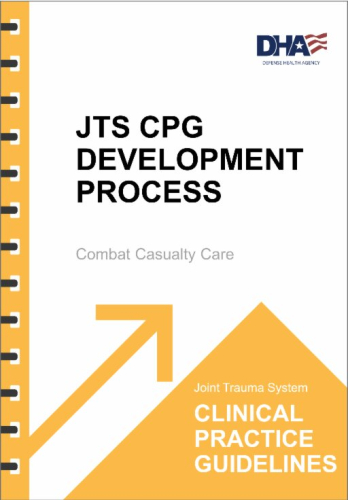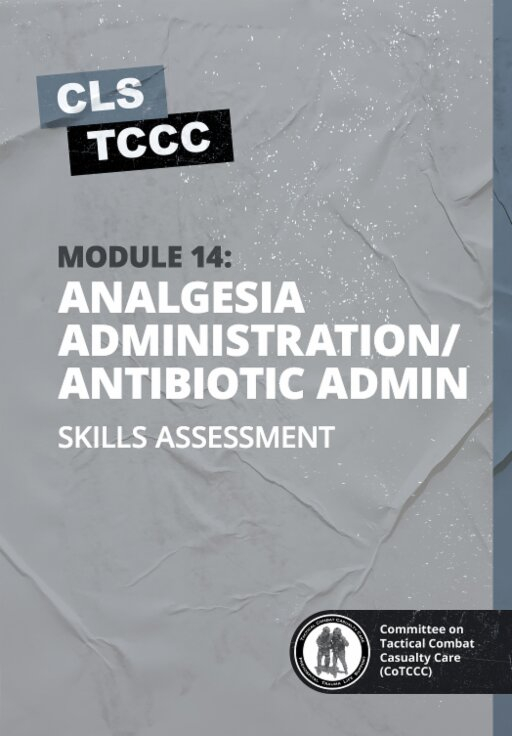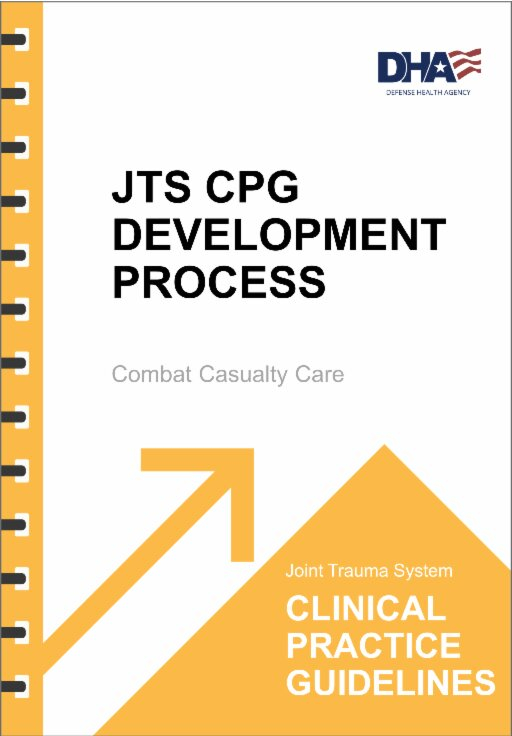
Introduction
The JTS CPGs were developed out of necessity to reduce variability in care, improve quality, measure outcomes, and weigh the benefits against the risks and costs of specific interventions. These CPGs provide recommendations to deployed clinicians about the care of trauma patients with specific conditions and are not a substitute for clinical judgment. The CPGs were developed through evidence- based research, systematic review of the literature, PI indicators and input from Subject Matter Experts (SMEs).
Background
CPGs are “statements that include recommendations intended to optimize patient care that are informed by a systematic review of evidence and an assessment of the benefits and harms of alternative care options.”1 To date, over 80 CPGs have been instituted to inform the standard of care for the US military in the deployed setting and are reflective of the current “state of the art” at the time of release.
CPGs are developed based on the best available evidence and SME consensus, providing clinicians with recommendations to improve the quality of care, standardization of care and serve as an educational resource while deployed. A systematic and operationally responsive approach to development, verification and implementation of CPGs is taken to ensure rapid field dissemination and provide quality indicators to measure effectiveness. Department of Defense (DoD) trauma cases worldwide are reviewed for CPG compliance by JTS in accordance with PI metrics specified at the end of each CPG.
JTS guidelines may be updated frequently based on operational need and clinical observations and have all been written by SME volunteers. CPGs undergo revisions when the clinical or operational need arises. The JTS CPGs currently do not meet the National Academies of Sciences Engineering and Medicine standards for CPG development 1 to facilitate expediency, responsiveness to the military operational environment and rapid performance improvement. In some cases, there may be little published literature (military or civilian) to guide battlefield or operational medicine, requiring heavy reliance on SME opinion or unpublished analysis of military data. JTS CPGs are timely and reflect evolving threats, technologies, and current realities on the battlefield. The JTS recommends every deploying clinician in their respective Combatant Command (CCMD) who will be providing care for casualties becomes familiar with the CPGs posted on the JTS website.
Strong evidence demonstrates CPG compliance is associated with a reduction in mortality.2-4 The Donabedian Model for quality improvement in health care states that, besides patient characteristics, institutional structures and clinical practices determine patient outcome. 5 Evidence-based CPGs are developed to avoid unnecessary variation and promote consistency in healthcare practice throughout the continuum of care to achieve optimal outcomes. JTS CPGs complement the deployed PI process. Since the early days of the U.S. Central Command (USCENTCOM) trauma system, the guidelines have been developed and implemented by clinical SMEs in response to needs identified in the CCMD Area of Operations (AOR). More recently, as the trauma system has matured, the process for identifying, developing, vetting, approving, and implementing CPGs has also matured.
To the greatest extent possible, JTS CPGs are evidence-based. The evidence is derived from the published literature, to include analysis of combat casualty data. When evidence is lacking or unclear, yet a CPG is needed, guidelines are developed based on the best available evidence and SME consensus. In order to ensure CPGs include the latest techniques and innovations, monitoring of all CPGs is essential. To ensure monitoring, each individual CPG will include a system-level PI monitoring plan. Monitoring specifics (e.g., timing, frequency, performance measures) are written in the PI monitoring plan for each CPG. This system-wide monitoring will be conducted by the JTS PI Branch. The PI plan will state the intent and minimum performance measures that will be utilized for monitoring. Trauma directors or their equivalents at the deployed military treatment facility level are expected to implement local PI processes to ensure appropriate adherence to the CPGs; the PI monitoring plan will help guide these efforts. Routine updates to CPGs occur every five years or as the operational need arises or as new evidence surfaces. SMEs include, but are not limited to, military and DoD civilian experts, deployed clinicians, Service specialty consultants, trauma medical directors, trauma program managers, JTS Branch Chiefs, and trauma PI nurse analysts.
Although the JTS CPGs were originally developed for USCENTCOM, they are no longer specific to any particular CCMD or contingency. JTS CPGs are patient-centric guidelines with the intent of keeping the medicine joint and agnostic of Service or location. Because CCMDs greatly differ in climate, terrain, and resources, the JTS CPGs are not representative of a specific CCMD or contingency. Services, unit organizations, and trauma directors may tailor to unit missions, deployed settings, and unique situations.
CPG Development
Topic Identification
Any DoD Service Member can propose a topic for CPG development or revision to the JTS CPG Manager. (See Appendices A-C for process flow charts.) At a minimum, a new CPG topic must include:
- A description of the proposed guideline and perceived gap in care.
- Identification of end-users of the guideline.
- Identification of changes in performance to be driven by the guideline.
Topic Selection
The JTS clinical leadership (DCoT Chief, DCoT Committee Chairs, PI Chief, and JTS Chief will determine the need for the proposed CPG topic based on:
- Relevance to the deployed combat casualty environment
- Potential for reduction of clinically significant variations
- Incidence, prevalence, or trend identified by DoD Trauma Registry data
- Evolution of best practices
- Findings and implementation of lessons learned
- Requests from theater/CCMD/Service
- Target audience of CPG (prehospital, en route care, role 2/3)
Submit CPG topic recommendations to: dha.jbsa.healthcare-ops.list.jts-cpg@health.mil
Key CPG Development Steps
Once the proposed CPG topic is approved, DCoT Committee Chair with CPG Manager will initiate the CPG process:
- Identify lead author
- Identify sponsor (generally a DCoT committee will sponsor a CPG)
- Crosswalk with other existing projects/proposals
- Provide literature review/data retrieval support as needed
CPG Content Requirements
At a minimum the CPG must contain the following:
- Summary of changes if CPG update
- Background and/or introduction
- Evaluation
- Treatment
- PI metrics (provided by PI team)
- Source references
- Credential information for working group (rank, branch of service, title (MD/DO/RN, etc.)
Responsibilities

CPG Manager
The CPG Manager will:
- Cross reference proposals with existing CPGs.
- Identify way ahead course of actions (COAs)
- Present COAs to JTS clinical leadership (DCoT Chief, DCoT Committee Chairs, PI Chief, and JTS Chief) for decision.
Lead Author
The lead author will:
- Serve as the point person to the DCoT CPG manager throughout the entire process. (See note below.)
- Develop an editorial working group comprised of SMEs. A working group ideally will include 5 to 10 experts representing all U.S. military services. Input from civilian and foreign military SMEs is permissible but should not substitute for U.S. tri-service input.
- Identify and disclose any potential conflicts of interest.
- Draft CPG structure.
- Conduct a review of the literature.
- Define responsibilities and development timeline.
- Coordinate with the working group.
- Draft CPG.
- Coordinate with JTS PI team to establish PI metrics.
- Identify research, development, test, and evaluation requirements.
- Submit draft CPG to JTS CPG manager for distribution to reviewers.
- Collate and reconcile working group and SME input.
- Prepare final draft of proposed CPG for review.
- Distribute the CPG proposal to the working group to create the draft CPG.
- Review available evidence and produce a working draft of the new CPG.
- Collate and reconcile working group and SME input.
NOTE: The JTS may identify an Academic Action Officer to assist the lead author with literature collection, literature review, and drafting CPG text.
Peer Review & Approval
- Draft is received from lead author - Chiefs/Chairs will review initial draft.
- The sponsoring Committee Chair will send the draft to one of the following for review:
- Specified individual SMEs
- Select committee
- DCoT members
- CPG manager will send draft to select committee for review and vote for approval.
- CPG manager will send draft to DCoT members for review and vote for approval.
- DCoT CPG manager will consolidate comments for adjudication by the lead author.
- After the comments are adjudicated, the CPG will be sent to DCoT Chief in conjunction with PI Chief for approval.
- The technical writer will route the final draft to the JTS Chief for approval. (The JTS Deputy Chief can sign off on the CPG for publication if the draft has been previously reviewed the Chief.)
- Upon JTS Chief approval, the technical writer will forward the CPG to DHA for Public Affairs Office/Operations Security (PAO/OPSEC) review and approval. The approved CPG will then be published on the JTS CPG web-based platforms.
NOTE: Approval authority for implementation of the CPG in any CCMD rests with each CCMD. See Implementation of JTS CPGs below.
Review & Update of Existing JTS CPGs
- Existing CPGs will be revised at least every five years, or sooner in response to clinical or operational needs. (See Appendix B and Appendix C for process in flow chart.)
- The JTS PI Branch Chief/DCoT will review each CPG to determine the need for significant revision.
- If an update is needed, the PI Branch Chief/DCoT will initiate the update by inviting the current CPG’s lead author(s) to head the revision process.
- If the lead author has separated from the military or declines, a new lead author will be identified, and the revision process will follow that of a new CPG.
- If no update is required as determined by the JTS PI Branch Chief/DCoT, the CPG is submitted to the JTS Chief for re-approval.
- The JTS PI Branch Chief/DCoT will approve all proposals for rapid/routine updates, clinical enhancements, specific population, and operational considerations to an individual CPG. This approval will create an abbreviated review process for rapid update and will not affect the publication date of the CPG. (See Appendix A-C for detailed processes.) The lead author, and the editorial working group at its discretion, will review these updates for inclusion into the CPG. These updated CPGs will be forwarded to the JTS PI Branch Chief/DCoT Chair(s) for approval before sending to the JTS Chief for final approval.
- Upon approval, the CPGs will undergo PAO/OPSEC review prior to posting on the JTS CPG webpage and Deployed Medicine.
Publication & Dissemination
CPGs will be published posting on the JTS website and Deployed Medicine App. The CPG will be socialized through infographics, social media campaigns and though the weekly Combat Casualty Care Conference. See Appendix D for a list of dissemination activities.
-
- IOM (Institute of Medicine). Clinical practice guidelines we can trust. Washington, DC: The National Academies Press, 2011.
- Shafi S, Barnes SA, Rayan N, et al. Compliance with recommended care at trauma centers: association with patient outcomes. J Am Coll Surg. 2014;219(2):189-98.
- Eastridge BJ, Costanzo G, Jenkins D, et al. Impact of joint theater trauma system initiatives on battlefield injury outcomes. Am J Surg, 2009;198(6): 852-7.
- Bailey JA, Morrison JJ, Rasmussen TE. Military trauma system in Afghanistan: lessons for civil systems? Curr Opin Crit Care, 2014;19(6):569-577.
- Donabedian, A. The quality of care. How can it be assessed? JAMA. 1988;260:1743–1748.
Appendix A: New CPG – Full Review

Send CPG inquiries to: dha.jbsa.healthcare-ops.list.jts-cpg@health.mil
Appendix B: Routine CPG Update

Send CPG inquiries to: dha.jbsa.healthcare-ops.list.jts-cpg@health.mil
Appendix C: Rapid Update

Send CPG inquiries to: dha.jbsa.healthcare-ops.list.jts-cpg@health.mil
Appendix D: CPG Dissemination Campaign

Appendix E: CPG Education Content Development





























